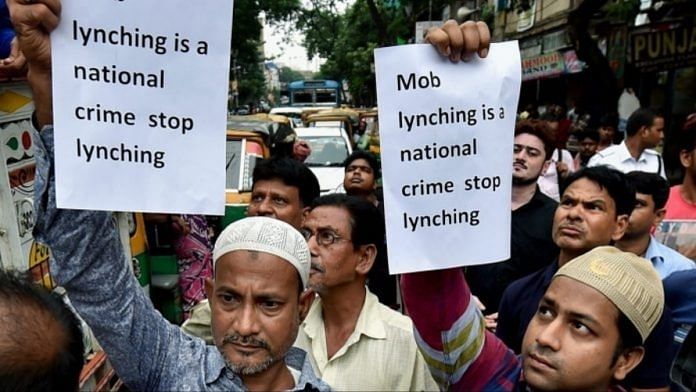New Delhi: Vigilantism functions as a method for Hindu right-wing groups in India to consolidate success in electoral politics, and accelerate enforcement of their “ideological vision at the grassroots level”, a new paper has argued.
Titled Right‐Wing Populism and Vigilante Violence in Asia, the paper is a comparative analysis of India and Indonesia, looking to identify factors behind the usage of vigilantism to dismantle “democratic protections against majoritarianism” by right wing groups in both countries.
It has been authored by Sana Jaffrey, who is Director of the Institute for Policy Analysis of Conflict in Jakarta.
The paper was published on 30 June in Issue 56 of the journal Studies in Comparative International Development, which was guest edited by Ashutosh Varshney, Sol Goldman Professor of International Studies and the Social Sciences and Professor of Political Science at Brown University, US.
Jaffrey announced the open access public release of the paper on 5 August.
Open Access: In a new paper I explain why Indonesian Islamists and Indian Hindu Nationalists use vigilante violence for dismantling democracy from the bottom up. Thanks @ProfVarshney for including me in this SCID special vol and to anonymous reviewers for helpful comments. https://t.co/10HHz1fbQT pic.twitter.com/ty5jihkDIV
— Sana Jaffrey (@sdjaffrey) August 5, 2021
Also read: Family of UP man shot over ‘cow smuggling’ says ‘well known gau rakshak’ trapped & killed him
What the paper says on India
Jaffrey’s paper on right-wing populism and vigilantism in India primarily focuses on the rise of Hindutva since 2014 when the Bharatiya Janata Party (BJP) came to power under Prime Minister Narendra Modi.
While she provides a historical background of the Partition of India, the adoption of secularism, and Hindu nationalism in the 1990s, the majority of the paper’s sections on India and citations are from 2014 or later.
Jaffrey provides some data points before delving deeper into her claims on vigilantism in India being used “as a systematic strategy for undermining minority rights at the grassroots level”.
“Data from India recorded 254 incidents of mob violence targeting religious minorities between 2009 and 2018, resulting in 91 deaths and 579 injured victims… About 90% of all recorded cases took place after BJP’s electoral victory in May 2014,” she writes, citing data journalism platform, IndiaSpend.
Jaffrey says there has been a shift away from the widespread scale of communal riots to activities like cow vigilantism, moral policing on Valentine’s Day, “anti-love jihad squads” and the “ghar wapsi initiative”. The 2020 Delhi riots don’t find a mention in the paper.
“An overwhelming majority of victims of deadly communal lynching (74%) have been Muslim, while the rest are Dalits,” Jaffrey says on beef-related vigilantism, citing IndiaSpend.
On the role of the state in this surge in vigilante violence, Jaffrey says, “In India, right-wing vigilantism tends to be far more brutal and deadly as its police structure is highly susceptible to vigilantes’ demands for impunity. This is because right-wing populists exercise direct control over a highly decentralized police force.”
Comparisons with Indonesia and concluding arguments
Given the main focus of her paper, Jaffrey maintains that vigilantism is rising in a “concurrent” manner in both India and Indonesia. However, “important ideological differences” exist between the two, she notes.
While Hindutva supporters in India aim at “establishing dominance over non-Hindu minorities”, Indonesia’s Islamists not only battle with non-Muslim minorities but also with “moderate Muslim organizations that have fared well in the secular state”, Jaffrey writes.
However, while the electoral power held by Indonesian Islamists differs greatly from that of Hindu nationalists in India, Jaffrey’s argument rests on the idea that the factors driving vigilantism by right-wing groups in both countries are similar.
Jaffrey reiterates these factors in her conclusion, claiming that majoritarianism is far from the only explanation for “the systematic use of vigilantism”.
“First, because pluralist constitutions make it difficult to curtail minority rights through top-down legislation, vigilantism has emerged as an appealing extralegal strategy for undermining these rights from the bottom up,” she writes.
“Second, widespread social legitimacy associated with everyday forms of vigilantism allows right-wing populists to scale up local templates of violence for national goals,” she adds. “Third, similar pathologies of state-building in both countries have enabled right-wing vigilantes to obtain impunity for violence by colluding with state officials.”
Also read: The ‘difficulty factor’ reports like Freedom House miss before ranking democracies



